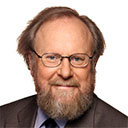
Wolfgang Thierse
Wolfgang Thierse (SPD) was a member of the Bundestag from 1990 to 2013. At the time of the debate, he was President (speaker) of the Bundestag and chairman of the Kunstbeirat (Arts Committee) when it deliberated the proposal of DER BEVÖLKERUNG.
Wolfgang Thierse (SPD):
Madam President. My dear colleagues. Art is freedom. That is its deepest essence.
(Applause from the SPD and portions of Alliance 90/Greens)
It allows for differences, invites argument, discussion, subjectivity, and the articulation of our individual taste, sensibility, emotion, and thinking. That is why differing aesthetic judgments are legitimate, and contradictory opinions are the norm, even those of politicians – and especially of parliamentarians. But, dear colleague Lammert, dear colleague Kauder, why must they be presented in such a cutting tone?
(Applause from the SPD and portions of Alliance 90/Greens and FDP)
Honorable Mrs. Vollmer, when you complain of the outrage, who instigated it? Differences of opinion in questions of art are normal and appropriate, even when, and especially when, the artist expressly encourages our participation. It is thus entirely legitimate that the full House of the German Bundestag is grappling with this project, particularly since the Bundestag is commissioning it.
But what should be decided here today and by what criteria? That is the real question. We are deciding whether an art project should be realized or not. I want you to know that I, too, have mixed feelings about this project and find many sound arguments both for and against it. I do consider the earth metaphor problematic. I have argued about it with Hans Haacke. And in 1990 we East Germans shouted “we are the people” and not “we are the population.” In the Arts Committee I reproached the artist for this as well.
(Applause from the SPD and portions of Alliance 90/Greens)
What sort of a decision are we to make here today? An aesthetic decision? Yes, of course. Even those who insist they are making a political decision have to admit that they are deciding the fate of an art project and that a political body, in this case the Bundestag, is deciding on an art project. You can’t dodge this decision.
(Applause from the SPD and portions of Alliance 90/Greens and PDS)
Now, one of the most prized possessions of our democracy – I want you all to be mindful of this – is that it has grown quite sensitive when facing awkward and incommensurate decisions about art. What would the history of art look like if the creation of artworks had depended on the more or less political decisions of majorities in legislative bodies?
(Applause from Ulrich Heinrich, the SPD, and portions of Alliance 90/Greens and PDS)
Just imagine what that art history would be like!
(Norbert Lammert: What does this mean for the project at hand?)
With your permission, I’d like to make an observation based on my experience in the GDR. Political bodies were constantly deciding on art there. I don’t want to make a one-to-one comparison, really I don’t, but this experience has made me very sensitive.
(Applause from Ulrich Heinrich, the SPD, and portions of Alliance 90/Greens and PDS)
Because the Bundestag had a feeling for the inappropriateness of political decisions on art, it created a special body, the Arts Committee, in which Representatives and art experts could work closely together, hold discussions with the artists, and then make a decision. We discussed Haacke’s project three times at great length and then we twice voted in favor of it. What we are considering here is a revision or a confirmation of this decision. It is a decision on an art project with intellectual and political ambitions. It is certainly not an artwork for decoration, beautification, or harmony, but rather an artwork of estrangement [Verfremdung]. Estrangement is a fundamental function of art.
(Applause from the SPD and portions of Alliance 90/Greens and PDS)
This artwork does not entail the eradication or rededication of the inscription “To the German People” but rather a commentary – an impetus to reflection, to make conscious our democratic commitment – on how we all understand the dedication on our Parliament building, “To the German People.” It is about renewing our awareness, through alienation, of what we are responsible for.
(Applause from the SPD and portions of Alliance 90/Greens and PDS)
If we wish, as has happened here, for a dialogue between parliamentarians and artists (dear colleague Vollmer, you are right), then the dialogue should precisely not be interrupted or prevented by a “no.”
(Applause from Ulrich Heinrich, the SPD, and portions of Alliance 90/Greens and PDS)
Art is freedom. That is certainly also true for your participation in this project; it is, of course, absolutely voluntary. Haacke has emphasized just this point. You won’t be forced to do anything, not even bringing the earth from your homeland.
(Applause from portions of the SPD) The explanatory text by the artist is not a part of the artwork. Where would we be in art history if we had to rely on artists’ texts and not the artworks themselves?
(Applause from Ulrich Heinrich, the SPD, and portions of Alliance 90/Greens and PDS)
Dear colleagues, art is freedom. Let’s keep it free! Let us demonstrate the confidence befitting the Bundestag in the fifty-first year of its successful existence! Let us not react defensively out of fear or rage but rather embrace the ambitions and contradictions of the art project by Hans Haacke!
(Applause from Ulrich Heinrich, the SPD, and portions of the Alliance 90/Greens and PDS)
Vice President Bläss:
I am now closing the debate.
